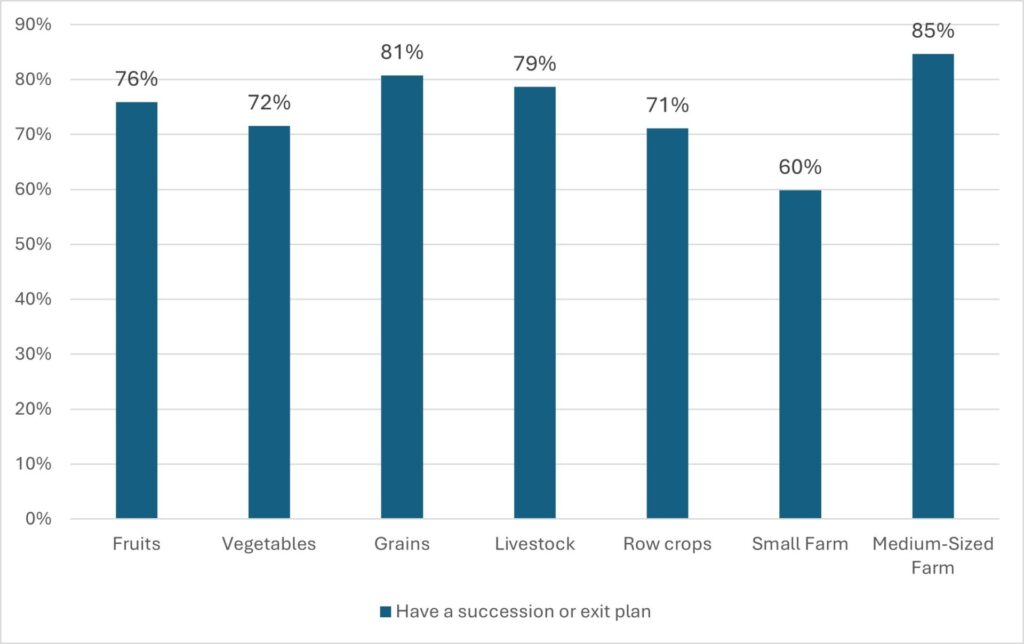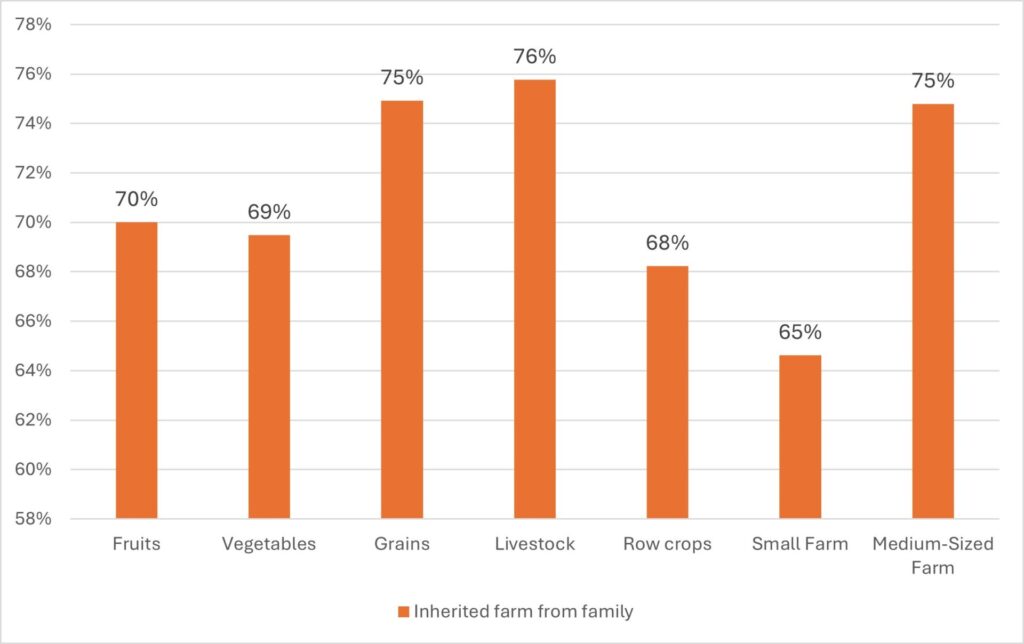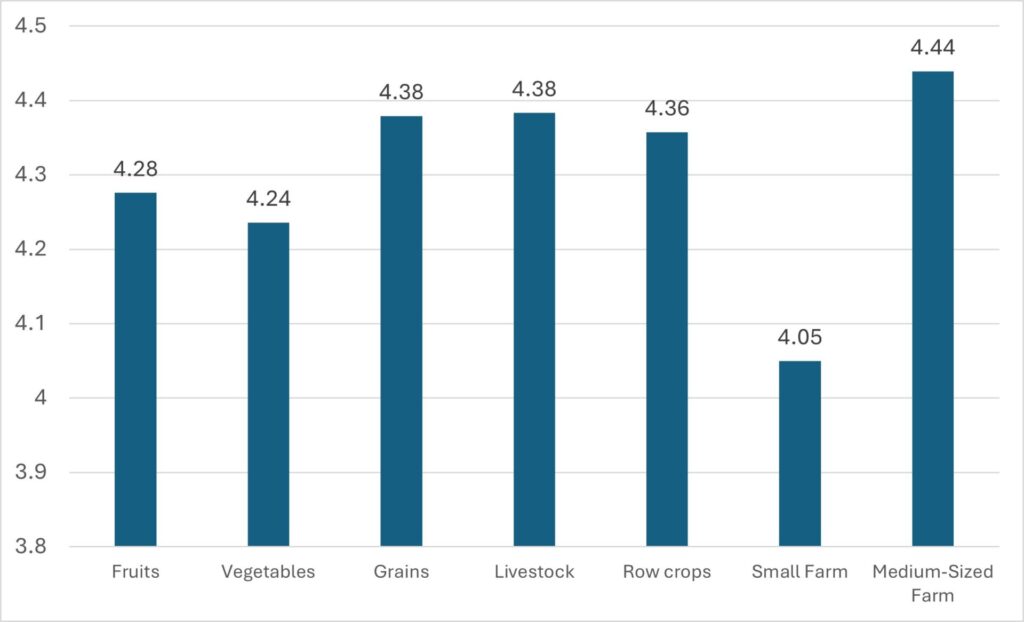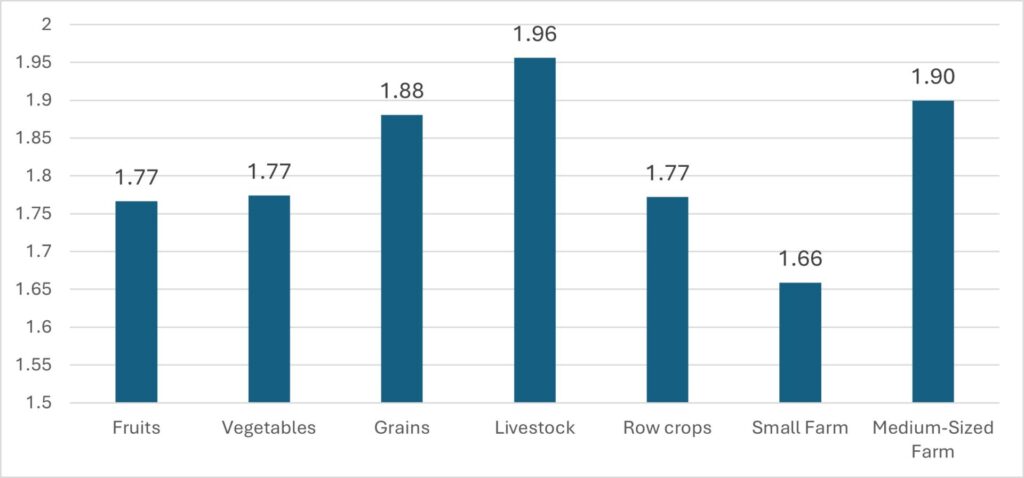The survey examined how farmers integrate decisions across three critical areas: farm business planning, production management, and food safety practices. Participants were asked detailed questions about their operational decisions, the timing of various planning activities, and the people involved in farm decision-making processes. The research team sought to understand what decisions farmers make and when and how these decisions occur throughout the production cycle.
This article series will present key findings from the survey, offering insights that can help both growers and Extension educators better understand the interconnected nature of farm planning. These findings aim to support more profitable and sustainable vegetable farming operations by examining the relationship between strategic planning and farm performance.
Succession, Family, and Success: Differences Across Farm Size and Farm Type
While the primary focus of the Soil to Market Producer Survey collected in 2024-2025 was to explore the decision-making of U.S. farm producers with respect to appropriate scale management strategies and practices to enhance economic efficiency and sustainability, it also gathered data on other topics. Some of these topics include farm demographics, business success, farm growth, and farm succession. In this article, we examine the data on succession, success, farm size, and generations of family involved in day-to-day management by farm type (fruits, vegetables, grains, livestock, and row crops) and by farm size (small farm or medium-sized farm).
Although all farmers in this survey were vegetable producers, they could also grow other crops such as fruits, grains, livestock, and row crops. Roughly 52.2% of producers indicated that they also produced fruits, 65.4% produced grains, 45.4% produced livestock, and 38.6% produced row crops (such as field corn or soybeans). USDA defines small family farms as those with an annual gross cash flow income (GCFI) of less than $350,000; mid-size farms have a GCFI of $350,000 to $999,999; and large-scale farms are those with a GCFI of $1 million or more (Dorn, 2021). Large-scale farms were excluded from this survey and analysis. Figure 1 reports the average number of acres farmed by farm type and size. Not surprisingly, medium-sized farms reported, on average, farming roughly 381 acres, compared to small farms averaging 85 acres. Row crop farmers have the highest average number of acres farmed, with 304 acres, followed by grain farmers with an average of 267 acres.
According to the 2017 Census of Agriculture, roughly 96% of all farms in the United States are family farms (Nseir & White, 2021). In our producer survey, we asked the simple question as to whether the farm business was a family business. The Census of Agriculture defines a family farm as one “where the majority of the business is owned by the producer and individuals related to the producer” (Nseir & White, 2021). However, when farmers in our national survey were asked whether their operation was a family business, it was open to their own definition and interpretation. Farmers may decide that their farm is a family business because they work with their family, co-own with their family, or because they farm land that has been in their family for generations. In our sample, roughly 66.8% of the producers surveyed reported that their farms were family businesses.
Figure 2 shows the percentage of each category that respondents have a succession or exit plan, and Figure 3 shows the percentage of farms per category that inherited the farm business from a family member. Please note that while small farms and medium-sized farms are mutually exclusive, the same is not true for fruit, vegetable, grain, livestock, and row crop farms. Medium-sized farms had the highest rate of having a succession or exit plan, with 85% responding positively to that question. The lowest rates of both having a succession/exit plan and having inherited the farm business from a family member are small farms. Of the enterprise types, grain farms are most likely to have a succession/exit plan, with 81% of respondents indicating a positive response, and livestock farms are most likely to be inherited from family members.
Figure 4 shows the average level of success reported when the farm owner/operator was asked how successful they consider their business. The scores ranged from 1, which indicated very unsuccessful, to 5, which indicated very successful. On average, all enterprise types and sizes reported (on average) between somewhat successful (4) and very successful (5). However, medium-sized farms reported the highest level of success with an average of 4.44 compared to small farms’ average of 4.05. Of the farm types, the highest levels of success were reported among grains and livestock farms.
Figure 5 shows the average number of generations in the day-to-day management of the farm business. Of the whole sample of farmers, roughly 38% reported that one generation was in the daily management, roughly 46.6% of farms reported that two generations were in daily management, and 15.4% reported that three generations were involved. On average, livestock farmers have more generations involved in daily management than any other type of farm, followed by grain farms. Medium-sized farms reported (on average) roughly 1.9 generations involved in daily management of the farm and small farms reported roughly 1.66 generations.
There can be large differences found among farm size and farm type. Medium-sized farms in our national survey are more likely to have a succession/exit plan, but livestock farms are most likely to have inherited the farm from a family member. Not surprisingly, livestock farms have the most generations involved in daily management on average. Medium-sized farms had the most acres farmed on average and also rated themselves as more successful than small farms or other enterprises on average.
References
Dorn, T. (2021, January 27). Family farms continue to power U.S. agriculture. U.S. Department of Agriculture. https://www.usda.gov/about-usda/news/blog/family-farms-continue-power-us-agriculture
Nseir, A., & White, T. (2021, January 22). Family-owned farms account for 96% of U.S. farms, according to the Census of Agriculture Typology Report: Small family farms make up 88% of all U.S. farms. USDA Census Counts Newsroom. https://www.nass.usda.gov/Newsroom/archive/2021/01-22-2021.php
Wiatt, R., Marshall, M.I., Feng, Y., Langenhoven, P., and Shoaf, N. (2024-2025). Soil to Market Producer Survey on Integrated Decision-Making Survey [data file and codebook]. IRB-2024-1552. Funded by USDA-NIFA-AFRI: Taking the Next Step as a Small and Medium Sized Farm: Understanding the Integration of Production, Food Safety, and Profitability.
Funding Acknowledgement
This work is supported by the Agriculture Food Research Initiative-Small and Medium Sized Farms Program, project award no. 2021-68006-33893, from the U.S. Department of Agriculture’s National Institute of Food and Agriculture.
Any opinions, findings, conclusions, or recommendations expressed in this publication are those of the author(s) and should not be construed to represent any official USDA or U.S. Government determination or policy.





